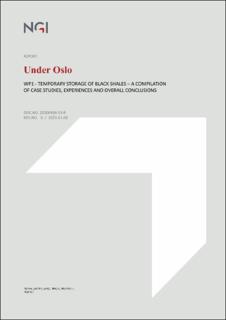| dc.description.abstract | As a part of the internal R&D project "Under Oslo" at NGI, several aspects of temporary storage of black shale has been investigated. Information from different experiments and cases of black shale storage from the Cambro-Ordovician stratigraphy in the Oslo area have been gathered.
For the large scale, outdoor experiments with fresh black shale, minimum 14 months was necessary for acid rock drainage (ARD) to start. This is because the black shales have an inherent buffer capacity in the form of carbonates that buffers the acid and cannot be expected for already weathered shale where part of the buffer capacity may have been consumed. For small-scale column experiment at room temperature, the pH dropped after about 10 months.
Two cases of self-heating in alum shale are described. In both cases, the time until significant self-heating was more than a year. Factors affecting this probability will likely be reactivity of the rock masses (e.g. content of sulphides and neutralizing material), size distribution and porosity of the rock masses, storage conditions including height of pile, moisture and air circulation in the pile. Covering masses with tarpaulin can both increase and reduce the risk of self-heating.
One stage batch leaching tests are not appropriate for assessing the acid-producing properties of black shale, but may give information about the degree of weathering of the material. However, even by ongoing ARD, crushing the material can release carbonates resulting in neutral pH.
Downstream water quality of three sites with neutral leaching from black shale is presented and are mainly within environmental guideline values. Some elevated uranium values were however observed. Tests with different basic materials for neutralizing ARD gives varying results, showing the need for testing materials before use.
Based on the results of all these findings, a maximum of 6 months temporary storage before final disposal of acid producing black shales is recommended. This time period includes temporary storage at the disposal sites before the masses are properly covered. | en_US |
